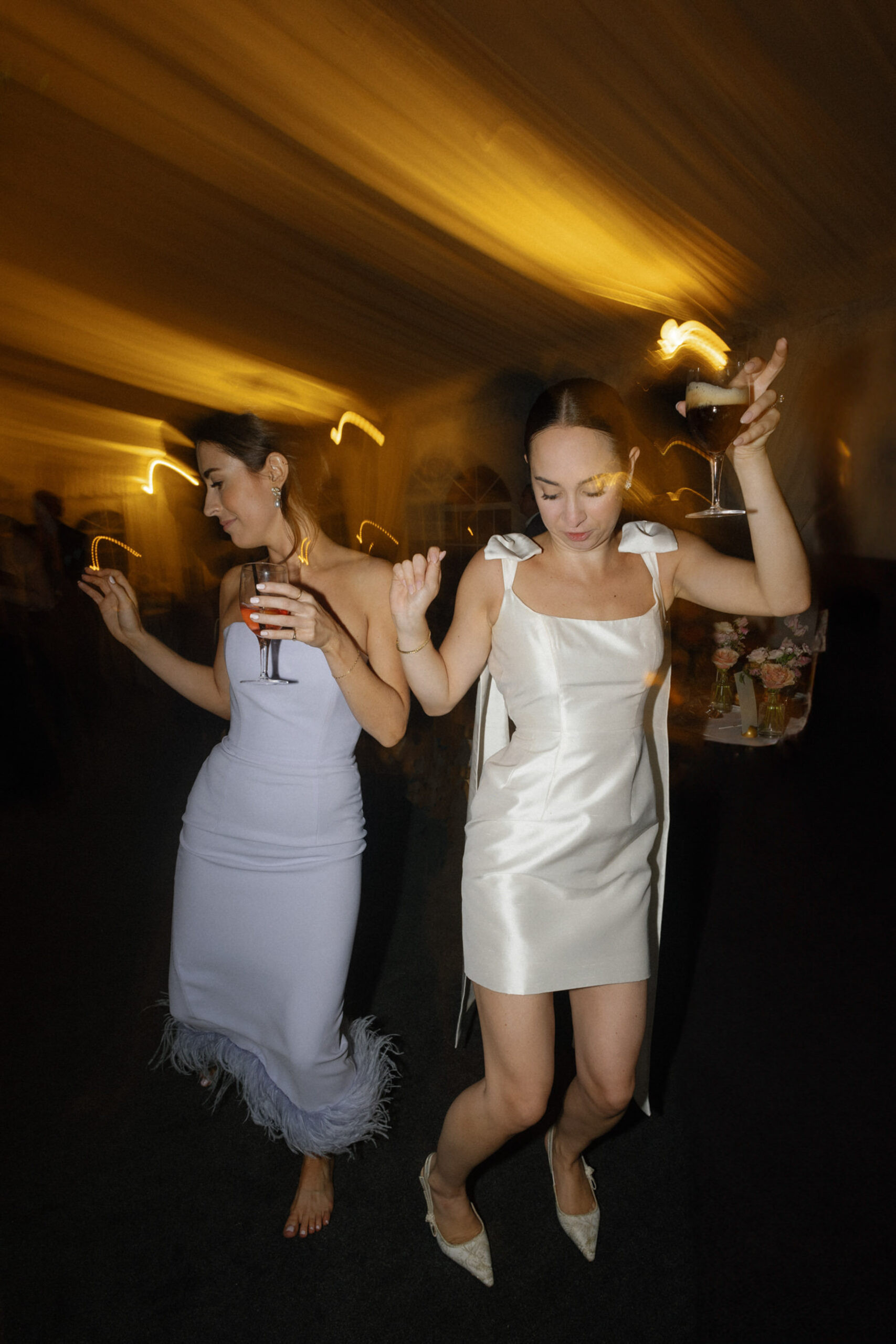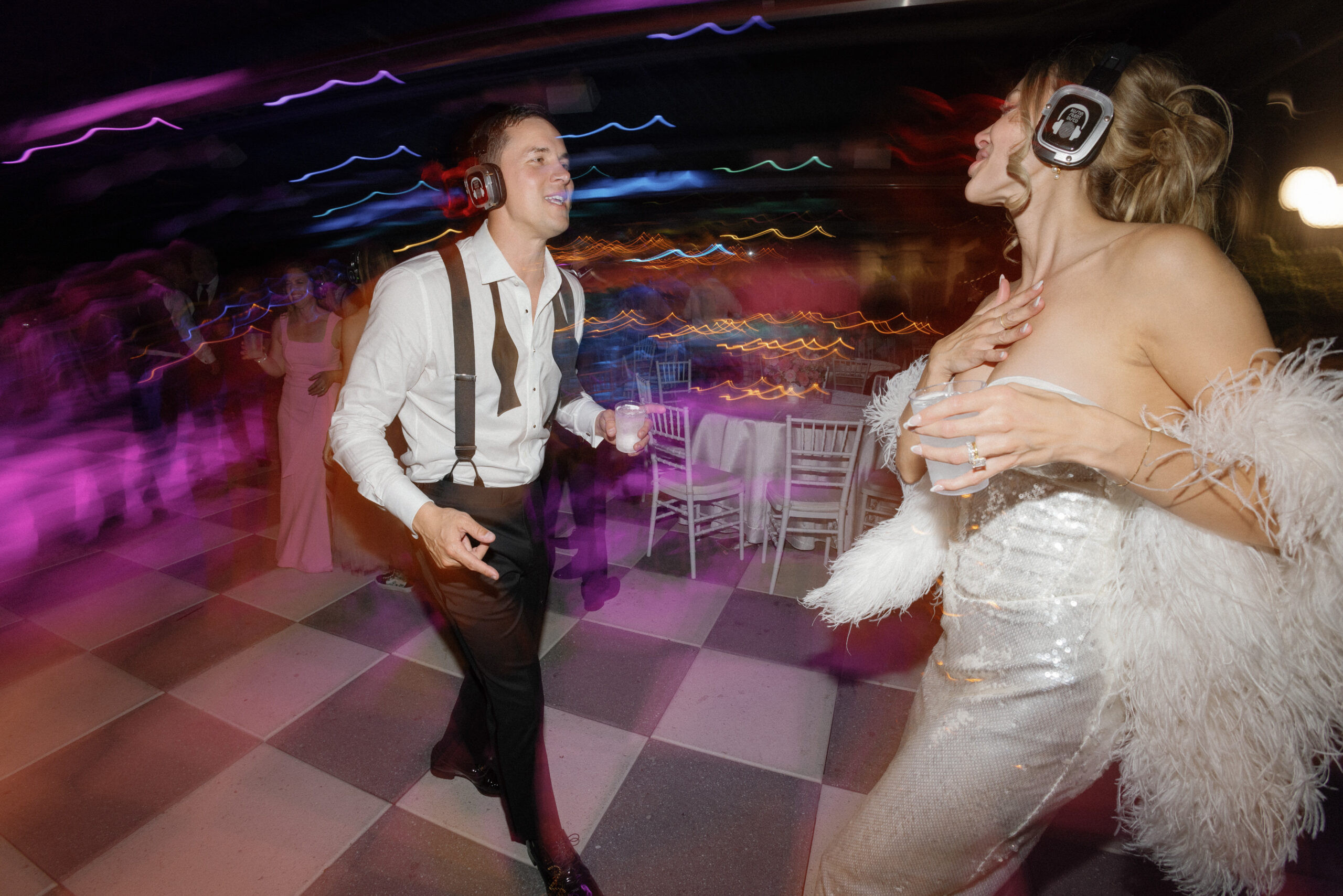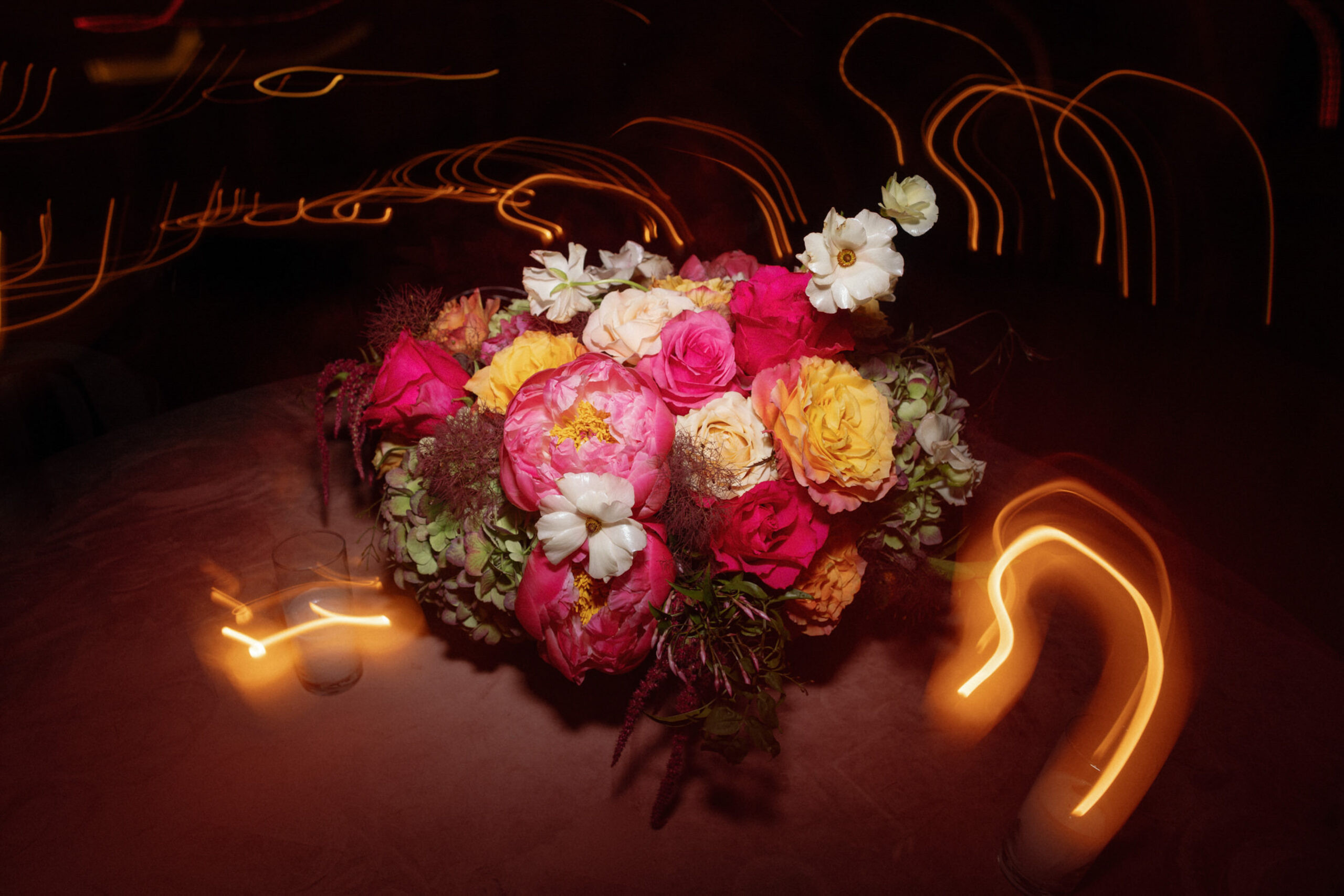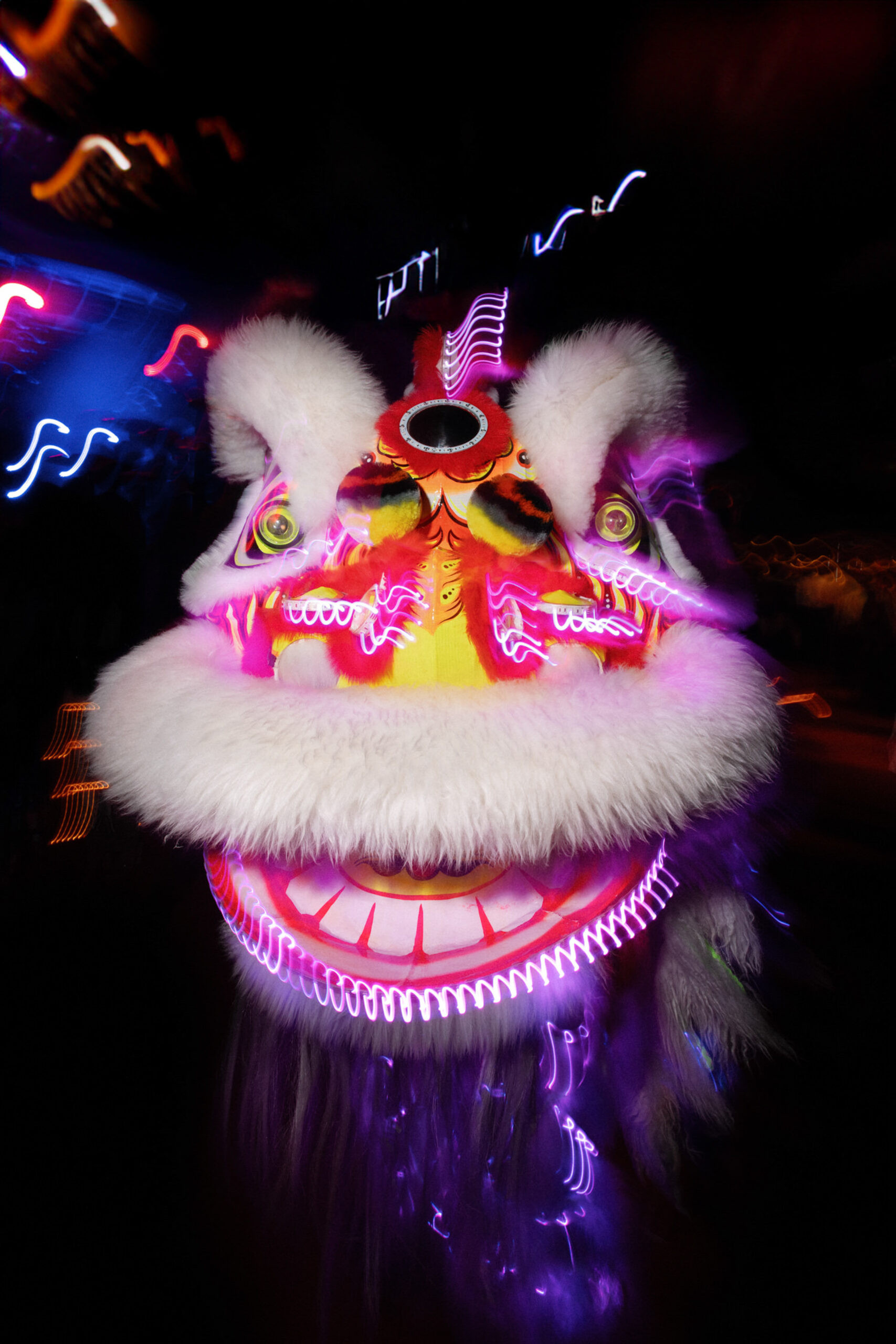Wedding photography is about capturing moments, and few moments are as full of life and energy as the Wedding Dance Floor. As a wedding photographer, you’re always looking for ways to make your work stand out and deliver images that truly reflect the atmosphere of the celebration. One technique that can transform your dance floor photos from ordinary snapshots into dynamic works of art is shutter drag, also known as motion blur. This technique injects vibrancy and a sense of movement, perfectly encapsulating the joyous chaos of a wedding dance floor.
 bride dancing with guest at wedding reception shutter drag
bride dancing with guest at wedding reception shutter drag
Understanding Shutter Drag for Wedding Dance Floors
Shutter drag, or motion blur, is a photographic technique that combines a slow shutter speed with flash to capture both sharp and blurred elements in a single image. For wedding dance floor photography, this means freezing your subject – the dancing couple or guests – with a burst of flash, while the background, lit by ambient or party lights, becomes a beautiful blur of motion. This contrast creates images that are not only technically interesting but also emotionally resonant, conveying the feeling of movement and excitement on the wedding dance floor.
Essential Gear for Shutter Drag on the Dance Floor
To effectively use shutter drag for wedding dance floor photography, you’ll need a few key pieces of equipment and an understanding of their manual settings:
- Camera with Manual Mode: Essential for controlling both shutter speed and aperture.
- External Flash with Manual Mode: Crucial for providing the burst of light to freeze your subject while allowing background blur. On-camera flash is perfectly suitable for this technique on the wedding dance floor.
- Wide-Angle Lens: Lenses in the 16mm to 24mm range (on a full-frame sensor) are ideal for capturing the action on a crowded wedding dance floor and enhancing the swirling background effect.
- Dark Environment with Accent Lighting: Shutter drag thrives in darker settings where background lights can create those desirable streaks of motion. Venues with string lights, DJ lighting, or uplighting are perfect for dynamic wedding dance floor shots.
When to Unleash Shutter Drag on the Wedding Dance Floor
Shutter drag is a fantastic technique, but it’s not for every moment of a wedding. It’s particularly effective during open dancing on the wedding dance floor when the energy is high and the movements are less structured.
Ideal Moments:
- Open Dance Floor: This is where shutter drag truly shines, capturing the uninhibited joy and movement of guests celebrating on the wedding dance floor.
- Bouquet Toss: The action is fast and dynamic, making it another good opportunity for shutter drag.
- Reception Exit: As the couple makes their grand exit, shutter drag can add a sense of celebratory motion.
Moments to Avoid:
- First Dance: Typically a more formal and intimate moment where you’ll want sharp focus on the couple and potentially utilize off-camera flash for softer, more flattering light that showcases the venue decor.
- Cake Cutting & Toasts: These are key events where clarity and capturing expressions are paramount. Shutter drag is generally not suitable for these moments.
 wedding dance party night bride shutter drag photography
wedding dance party night bride shutter drag photography
Why Shutter Drag Elevates Wedding Dance Floor Photos
Using shutter drag on the wedding dance floor offers several compelling advantages:
- Captures the Atmosphere: It visually represents the blur of motion and excitement that defines a lively wedding dance floor. The images feel more immersive and true to the experience.
- Creates Dynamic and Energetic Images: Motion blur adds an element of dynamism that static photos simply can’t achieve. It transforms ordinary dance shots into visually arresting images.
- Speeds Up Shooting: Once you’re comfortable with the technique, you can shoot quickly and intuitively, reacting to the action as it unfolds on the wedding dance floor. You can often shoot without constantly looking through the viewfinder, allowing you to be more reactive.
- Enhances Visually Simple Venues: Shutter drag can make even a plain room look vibrant and full of life by emphasizing the movement of light and people. It adds visual interest where the venue itself might lack inherent décor.
Step-by-Step Guide to Achieving the Shutter Drag Look
Let’s break down the process of creating stunning shutter drag photos on the wedding dance floor. These settings are a starting point and may need slight adjustments depending on the specific lighting conditions of the venue.
Camera Settings (Manual Mode):
- Aperture: f/5.6 to f/8: A slightly narrower aperture helps ensure your subjects are in focus, even with slight focusing errors, and provides sufficient depth of field for capturing dancers moving on the wedding dance floor.
- Shutter Speed: 1/4 second to 1/8 second: This slow shutter speed is key to creating the motion blur effect. Experiment within this range to find what works best with the ambient light and desired level of blur on the wedding dance floor.
- ISO: 100 to 400: Keep your ISO low to minimize ambient light and ensure the flash is the primary light source illuminating your subjects on the wedding dance floor.
Flash Settings (Manual Mode):
- Power: Start at 1/16 or 1/32 power: Begin with a low flash power as you’ll be close to your subjects on the wedding dance floor. Adjust as needed based on the room’s darkness and your distance to the dancers. ETTL (Through-The-Lens) flash metering can also be effective for quickly changing distances on a dynamic wedding dance floor.
- Zoom: 35mm to 50mm (or adjust for desired vignette): Zooming your flash head creates a focused beam of light, resulting in a natural vignette effect that draws attention to your subject and enhances the dramatic look of shutter drag on the wedding dance floor. Experiment with different zoom levels to control the vignette intensity.
- Flash Sync: First-Curtain Sync: Ensure your flash is set to first-curtain sync. This fires the flash at the beginning of the exposure, freezing your subject sharply at the start of the motion blur trail.
 Floral arrangement at wedding reception shutter drag
Floral arrangement at wedding reception shutter drag
Fine-Tuning Your Shutter Drag Technique
While the settings above provide a solid foundation, you’ll likely need to make minor adjustments based on the specific environment of each wedding dance floor.
Adjusting for Lighting Conditions:
- Flash Power: This is usually the first setting to adjust. If your subjects are too dark, increase flash power. If they are overexposed, decrease it.
- Aperture: For quick on-the-fly adjustments, especially if flash power adjustments are insufficient, slightly widening or narrowing your aperture can fine-tune exposure.
Creating Motion Blur:
- Camera Movement: The motion blur effect is achieved by the slow shutter speed capturing the movement of background lights as you move the camera slightly or as the dancers move.
- Controlled Movement: For elegant light trails, hold the camera relatively steady. For more dramatic swirls, gently wave or shake the camera during the exposure. However, avoid excessive camera shake that obscures your subjects.
Ideal Conditions for Shutter Drag Magic
Shutter drag works best in specific lighting scenarios. Recognizing these conditions will help you maximize the impact of this technique on the wedding dance floor.
- Dark Backgrounds with Bright Accent Lights: This is the sweet spot. Venues with darker walls or outdoor night receptions with string lights or DJ lighting create beautiful swirling backgrounds.
- Shooting Angle: Experiment with shooting towards and away from light sources. Shooting slightly away from direct light can prevent overpowering highlights and enhance the motion trails.
- Dealing with Bright Ambient Light: If the venue is too bright, try to have the venue lighting dimmed if possible. Alternatively, increase your flash power and potentially shorten your shutter speed to minimize the ambient light’s impact. Moving closer to your subjects can also help the flash become the dominant light source.
 Shutter drag Chinese dragon dance celebration at wedding.
Shutter drag Chinese dragon dance celebration at wedding.
Elevate Your Wedding Photography with Shutter Drag
Mastering shutter drag photography for the wedding dance floor is a valuable skill that will set your work apart. It allows you to capture not just images, but the very feeling of celebration, energy, and joy that defines a wedding reception. By understanding the technique, practicing your settings, and adapting to different lighting conditions, you’ll be well-equipped to create stunning, dynamic wedding dance floor photos that your clients will cherish. Embrace shutter drag and transform your wedding dance floor photography into something truly extraordinary.

